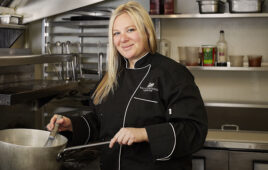Introducing small plates is a great way to add variety to your menus while also giving most of your senior members something they really want: smaller portions.
This season at Kelly Greens G&CC, we are rolling out a new small plates menu. These items are bigger than an appetizer but smaller than an entrée. Since discussing this with our management team, multiple members have told me that they are very excited to see this new menu. Most of them don’t care about the price point as they’re more excited about the overall portion size.
Our older members grew up in a time where money was tight and everyone had to finish any food on their plates. What was ingrained into these members is that if they order it, they need to finish it, or at least take the leftovers home.
This can be a big challenge when wanting to update your menus or introduce new items as these members are less willing to try something different knowing they will feel the need to finish it all, even if it’s not their most favorite thing. This can also lead to uncomfortable feelings for them, their appetites have decreased and their tastes have changed so taking risks with their dinner can be a big deal. The last thing we want to do as chefs is make anyone feel uncomfortable in our clubs.
Now study after study tells us that making children eat all of the food on their plate can lead to tension and fights over food which can lead to poor eating habits later in life. But as we educate the new generations, we still have to accommodate older generations.
Starting a small plates section on your menu can be a great step in the right direction to making everyone feel comfortable.
When you start a small plates menu there are a few things to consider.
- You’ll want to make sure it is priced right so that you don’t erode your overall average check, but also keep it attractive to other members to try something new.
- You also need to balance modern dishes with traditional dishes. I like to introduce items that push the boundaries more than our normal a la carte menus, but also offer a few comfort style items to round it out.
- You may find that the more adventurous items are the most popular small plates because members are more willing to take a chance on a smaller portion then they would a whole entrée.
- You should also weigh how adding additional menu items will affect your line operation. Multiple small plate dishes can take more time to plate then one or two entrees.
- Make sure you start the menu small, maybe five or six items and then expand it if the demand is there.
- Try to cross-utilize items that are currently on your a la carte menus but either change their preparation or combine it with other ingredients to create an entirely new dish. Cross-utilizing will help to keep prep work streamlined and will also allow you multiple areas to utilize product ensuring that it is always fresh.
- One other thing that we have done at Kelly Greens is offer the small plates menu only in the bar and lounge. We do not have menus to pass out but instead are using a table stand display for the menus. If a member wants a small plate item in the grill or dining room we won’t tell the deny them, but we also won’t be pushing this menu in those outlets either. This will help balance sales between small plates and main entrees and keep our average check and overall revenue on the same track.
Most clubs have a diverse membership with each group having different expectations. Introducing a small plates menu can help you meet these expectations while allowing you a new creative outlet to try out different dishes but the flexibility to change things quickly if they are not working. Some members will be happy with a smaller portion size and other will be happy with more verity. If things go well you can look at expanding the menu and introducing other items you think your members will appreciate.




